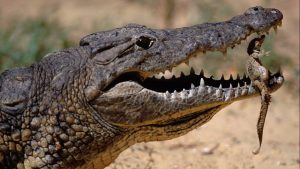Introduction
Crocodiles are fascinating creatures that have roamed the Earth for millions of years. Known for their prehistoric appearance and formidable nature, they have captured the curiosity and awe of people around the world. In this blog, we will explore 25 intriguing facts about crocodiles, including their physical features, hunting techniques, habitat, and conservation status.
- Ancient Lineage: Crocodiles belong to an ancient group of reptiles that have existed for over 200 million years. They are often referred to as “living fossils” due to their close resemblance to their prehistoric ancestors.
- Species Diversity: There are about 14 recognized species of crocodiles, including the saltwater crocodile, Nile crocodile, American crocodile, and more. Each species has unique characteristics and adaptations.
- Size and Weight: Crocodiles are known for their impressive size. The largest species, the saltwater crocodile, can grow up to 23 feet (7 meters) in length and weigh over 2,200 pounds (1,000 kilograms).
- Powerful Jaws: Crocodiles have one of the strongest bite forces in the animal kingdom. Their jaws are filled with sharp teeth designed for gripping and tearing apart prey.
- Ectothermic Adaptations: Crocodiles are ectothermic, meaning they rely on external sources of heat to regulate their body temperature. They bask in the sun to warm up and move to shade or water to cool down.
- Excellent Swimmers: Crocodiles are highly adapted to aquatic life. They have streamlined bodies, webbed feet, and powerful tails, allowing them to swim swiftly and silently through water.
- Ambush Predators: Crocodiles are ambush predators, patiently waiting for their prey to come near the water’s edge. They use their excellent camouflage and stealthy approach to surprise and capture their victims.
- Impressive Speed: Despite their large size, crocodiles are surprisingly fast on land and in water. They can reach speeds of up to 12-15 miles per hour (20-25 kilometers per hour) in short bursts.
- Longevity: Crocodiles have impressive lifespans, with some individuals living for over 70 years. Their slow metabolic rate and low predation risk contribute to their long lives.
- Parental Care: Crocodiles exhibit remarkable parental care. Females construct nests and lay eggs, which they guard fiercely. After hatching, the mother carries the hatchlings to the water and protects them for several months.
- Vocal Communication: Crocodiles use various vocalizations to communicate with each other. These sounds range from low-frequency rumbles and bellows to hisses and snorts.
- Social Behavior: While crocodiles are generally solitary creatures, they can congregate in groups called basks or congregations. These gatherings usually occur in areas with abundant food or during mating seasons.
- Powerful Tails: Crocodiles have muscular tails that play a crucial role in their movement. They use their tails to propel themselves through water and make quick turns while swimming.
- Clever Hunters: Crocodiles are intelligent hunters. They use various hunting techniques, such as “waterfalling,” where they submerge themselves near a riverbank and wait for prey to come to drink.
- Adaptations for Saltwater: Some species, like the saltwater crocodile, have specialized adaptations to live in saltwater habitats. They have glands that help them excrete excess salt, enabling them to survive in both freshwater and saltwater environments.
- Crocodile Tears: Contrary to popular belief, crocodiles do produce tears, but not as an emotional response. Tears help keep their eyes moist and remove debris.
- Feeding Habits: Crocodiles are opportunistic feeders. While they primarily feed on fish, they also prey on birds, mammals, and reptiles that come near the water’s edge.
- Regulating Population: Crocodiles play a crucial role in their ecosystems by regulating prey populations. They help maintain the balance of aquatic ecosystems by controlling the number of fish and other aquatic organisms.
- Environmental Impact: Crocodile nesting sites contribute to the formation of essential habitats for other species. Their presence influences the distribution and abundance of various plants and animals.
- Cultural Significance: Crocodiles hold cultural significance in many regions where they are found. They are often revered or feared and feature prominently in myths, folklore, and religious beliefs.
- Threats to Survival: Crocodiles face numerous threats, including habitat loss, illegal hunting, and pollution. The demand for crocodile products, such as skin and meat, has contributed to their decline in some regions.
- Conservation Efforts: Conservation initiatives have been implemented to protect crocodile populations. Breeding programs, habitat conservation, and stricter regulations on hunting and trade have helped in their conservation.
- Resilient Species: Crocodiles have survived multiple mass extinctions and have shown resilience in the face of changing environments. Their ability to adapt has allowed them to persist for millions of years.
- Ecotourism and Education: Crocodile-focused ecotourism provides opportunities for people to learn about these magnificent creatures while supporting conservation efforts. Responsible tourism can raise awareness and promote their protection.
- Coexistence with Humans: Despite their fearsome reputation, crocodile attacks on humans are relatively rare. By understanding their behavior and respecting their habitats, humans can coexist with crocodiles in harmony.
Conclusion
Crocodiles are remarkable creatures that have captivated our fascination for centuries. With their ancient lineage, impressive size, and powerful presence, they embody the raw power and beauty of the natural world. Understanding their biology, behaviors, and ecological importance is essential for their conservation and the preservation of the delicate ecosystems they inhabit. By appreciating these ancient predators, we can ensure their survival and the preservation of their unique place in the animal kingdom.




















Add Comment